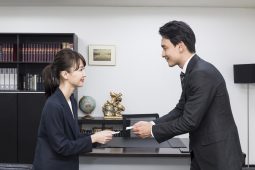If you work in a Japanese company, at some point a telephone is going to ring in your vicinity. Being able to answer it in a professional and competent manner will both impress your colleagues and help you feel like one of the team. Obviously, answering the phone in a foreign language can be intimidating, and this fact is compounded by the need to follow the rules of business etiquette. However, there are certain set expressions that you can learn in advance to help you prepare for this challenge. In this step-by-step guide we will introduce all the business Japanese phrases you need to confidently answer the phone at work.
1. Answering the phone
When answering a personal call on your own phone, the standard way to answer the phone is simply, 「もしもし」 (moshi moshi) which is the equivalent of the English “Hello”. However, moshi moshi is not appropriate if you are answering a business call. Just as you would in English, you should identify yourself and your company. But before you do that, there are three possible ways to greet the caller.
Before 11.00 am the standard way to answer the phone is this:
- おはようございます。X株式会社のスミスでございます。
ohayou gozaimasu. X kabushikigaisha no Sumisu degozaimasu.
“Good morning. X Company. Smith speaking.”
After 11.00 am, the greeting changes:
- お電話ありがとうございます。X株式会社のスミスでございます。
odenwa arigatou gozaimasu. X kabushikigaisha no Sumisu degozaimasu.
“Thank you for calling. X Company. Smith speaking.”
Ideally, the phone should ring no more than three times before you answer it. If the phone has rung more than three times before you can reach it, then you should answer as follows:
- お待たせいたしました。X株式会社のスミスでございます。
omatase itashimashita. X kabushikigaisha no Sumisu degozaimasu.
“I am sorry to keep you waiting. X Company. Smith speaking.”
2. How to ask for the caller’s name
If the caller fails to identify themself, you should ask:
- 失礼でございますが、どちら様でいらっしゃいますか
shitsurei degozaimasu ga, dochira-sama de irasshaimasu ka.
“Excuse me. May I ask who is calling?”
Alternatively, if the caller gives a name, but you couldn’t catch what they said, you should blame the connection and not the speaker:
- すみませんが、電話が遠いようなので、もう一度お名前をおっしゃっていただけますか。
sumimasen ga, denwa ga tooi you nanode, mou ichido onamae wo osshatte itadakemasu ka.
“I am sorry, but there seems to be a bad connection. Could you repeat your name again please?”
3. Confirm the caller’s details
After the caller has told you their name and company, be sure to repeat back those details.
- 株式会社Yの田中様でいらっしゃいますね。いつも大変お世話になっております。
kabushikigaisha Yno Tanaka-sama deirasshaimasu ne.itsumo taihen osewa ni natteorimasu.
“That’s Ms. Tanaka from Y Company, isn’t it? Thank you very much for calling.”
The formal expression お世話になっております is often used in business Japanese. The word お世話 literally means “care”, “assistance” or “looking after” something, but it is basically used to express gratitude. A literal translation of いつも大変お世話になっております would be “Thank you so much for always taking care of us”.
In Part 2 of this step-by-step guide we will look at the language you need to put a caller on hold, how to pass the call on to a colleague, and what to do if your colleague is not available.








